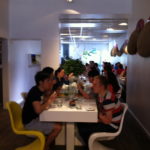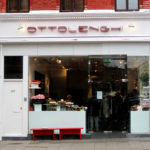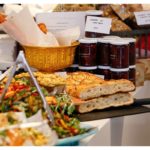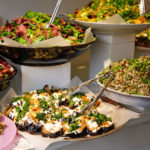Do you remember when mix & match salads first became a thing in this country? I don’t mean salad bars but places where they would give you four salads for a quid or whatever, so you might select a spoon of potato salad and one containing other veg or fruit or anything. Maybe you would choose some meat or fish or cheese on the side and it was a perfect lunch. Yes I know the salads were bought in, and also that supermarkets do that now with plastic tubs, but at the time it was a true novelty.
There were always a few high quality versions of the salad plate around, one of which I used to enjoy being a coffee and food place in Triton Square going by the name of Beany Green. Probably all changed now, but the piles of freshly-made salads there were a picture when I worked just around the corner, and available in a box with a slice of quiche or other delicious goodies to eat in or take out.
But then came Ottolenghi. Israeli-born Yotam Ottolenghi is, of course, a London culinary sensation, the man who has revolutionised fresh food cooking with more than a dash of Middle Eastern and Mediterranean flair, and made a name among the chattering classes (so-called by those who don’t chatter) in the pages of the Guardian Weekend section.
Ottolenghi revolutionised our view, not only of salads but also mains, that looked drop dead gorgeous, but were essentially dead simple to do at home, and, more to the point, introduced us to ingredients we probably hadn’t come across but were soon to be available in supermarkets too. Yes, I admit it! I did not invest in za’atar or sumac before I read about Ottolenghi using them. How shameful is that!
When my other half suggested Saturday brunch at Ottolenghi’s restaurant on Upper Street, Islington (round the corner from the Almeida theatre), I was thrilled but did not know quite what to expect, if only because there is usually a vast gulf between restaurant menus and the dishes they serve up in newspaper columns.
I realised we were probably a touch late for brunch but had no idea we would be heading for a venue dominated by salads and sweets to die for, but there they jolly well were. This is a trick so many restaurants miss: put your wares on display and a drooling foodie public will crawl over broken glass to try your food.
It works so well at The Greek Larder, to name but one, and, while chains are not my thing, even Carluccios (which is now nothing whatever to do with Antonio Carluccio, whose name is no longer mentioned) kept up the Italian deli trick with mouth-watering charcuterie, breads, cheeses, mushrooms, oils and pastas.
There of course are many more that do and are probably rewarded with increased footfall, but then if you start with a reputation like Ottolenghi the likely outcome is a restaurant buzzing from the first brunch to the last dessert and people queueing out of the door.
On this visit the queue was relatively light, which gave me an opportunity to take in the relatively slender contours of design, topped with the dessert, sweet, salads and savouries counter, the breads and wines and oils and fruits and veg to the other side, and of course books and DVDs. One must remember that Ottolenghi runs not just a restaurant but a one-man corporate merchandising industry where everything but everything is for sale.
Beyond the sales points begins the restaurant proper, marked by a long trench table beyond, reminding me slightly of street parties on royal occasions past. That description gives entirely the wrong impression since the decor is much more 1970s Tomorrow’s World, complete with white plastic walls, stackable plastic cantilever chairs, clean white plastic tables and powerpoints on flexi cables hanging down from the ceiling.
As an effort to mitigate the sheer minimalistic whiteness, strange wooden shapes daubed with a coloured layer have been attached to the walls further down, somewhere midway between a symbolic dragon and the Loch Ness monster, but certainly a talking point. By contrast, staff were dressed in black and moving up and around the table as if engaged in a large-scale chess game.
My partner had suggested it would be too noisy for my hearing, though I’ve known worse hubbub and worse acoustics too, not least at some branches of Wagamama. We were pitched either side of the first long table, a couple of seats up from the end, with small but amiable parties hemming us in on both sides. but were able to continue a reasonable conversation throughout – for which small mercy I am duly grateful.
The benefits of social dining are renowned. My favourite example remains the Company Shed at West Mersey, where my mother and I once ended up sharing somebody else’s champagne to wish them a happy wedding anniversary. No such luck at Ottolenghi, though we did enjoy a few moments lusting after one another’s food. That was how I came to order the plate of breads and olive oil, each of which were masterpieces of the artisan baker’s craft.
The menu is undeniably attractive, and undeniably expensive if you were to compare it to old-style salad plates, as mentioned above. I mean, £18.80 for a piece of meat, fish, quiche or croquettes plus two salads sounds a lot of dosh, doesn’t it. That is not quite the whole story though.
We both went for seared English fillet of beef with mustard, horseradish and rocket sour cream, which was cold, rare, thickly sliced, tasty and generous, about as many adjectives as you could wish to apply in one sitting. Our salads were equally generous, to the extent that my partner did not finish hers and chose to take the remainder home in a doggy bag – and how wonderful to hear we are acquiring the doggy bag habit this side of the pond.
The salads we chose, all beautifully composed and dressed to avoid any accusations of shocking nudity, were thus (top two hers, bottom two mine):
- Char-grilled broccoli with chilli and garlic
- Green beans and peas with moghrabieh (Lebanese big couscous) and salsa verde
- New potatoes (sliced and fried) and grilled courgette with truffle oil, red basil and pistachios
- Roasted romano peppers with zhoug (a fiery herb sauce not unlike spicy pesto), goat’s cheese and pine nuts
In so choosing we bypassed the likes of fregola (a type of pasta from Sardegna), butterbean mash, gem lettuce and aubergine, each of which had its own array of intruiguing accompaniments. Whether each works as well I can’t say but the ones we ate did not include a duffer – other than the courgette being a tad mushy, always a risk.
Each was seasoned delightfully and tasted in every sense vividly fresh. For example, it was a thrill to find both the broccoli and beans perfectly al dente, which is to say crunchy but not blatantly raw. There is a fine line in the blanching process, such that the veg become edible without losing all bite.
In the same way, I could not resist one of the gorgeous examples of patisserie at the front end of the shop, and in view of Ottolenghi’s article about cooked peaches in that day’s Guardian Weekend, what better than a cake of roast peach, raspberry and almond, topped with a gorgeous and chewy meringue. This we shared, though I will admit to having eaten the lion’s share. My finale was a good strong coffee, following which we strolled along the shops of Islington replete and contented.
I doubt very much that Mr O cooks in any of his five restaurants these days, but there is no doubt his influence and guiding hand remain strong.
Here’s the rub: when food is blatantly fresh and excellent quality, sourced and paired with precision and performing zingy back flips on your taste buds, you can see the value and enjoy it for what it is. I don’t resent the cost because the memories will last longer in my mind. So many places to eat, but a return trip would be well justified.
Actually, I hope more chefs learn from Ottolenghi – not commercially, though if it prevented more of them improving their art and not going out of business then it would be a blessing, but certainly in how to handle ingredients and understand customers and help the scales fall from their eyes and learn to love the unexpected.
The salad has indeed evolved since the days when it consisted of dry round lettuce leaves, a slice of tasteless tomato and a few sad slices of cucumber, all doused in Heinz salad cream. Vive le revolution!

















